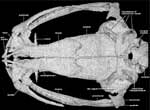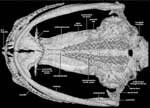 Expert annotations for this species! See below. Expert annotations for this species! See below.
Chiropterotriton priscus is a "misplaced" tropical salamander. It is a member of the supergenus Bolitoglossa, the tropical salamanders (a clade within the lungless salamander family Plethodontidae). This species occurs further to the north and east than any other member of the clade, and it is found in distinctly non-tropical habitats -- high elevation fir forests in the Mexican states of Nuevo León and Coahuila, south and west of the city of Monterrey. The grotesque vernacular name is a crude translation of the scientific name. The species is basically terrestrial and is found by day under fallen logs and tree limbs, under the bark of decaying logs, and under rocks. Like all tropical salamanders, C. priscus feeds with its long, fast tongue.
The skull of Chiropterotriton is very flattened. For a tropical salamander it is relatively well developed, but it is a "stripped-down" version in comparison to other salamanders (for example, Dicamptodon). Key features are illustrated below and in the coronal slice animation.
Lateral View
 | Chiropterotriton priscus, lateral view. |
|
Viewed laterally one can see the large posterior, ventrally oriented parietal tab that is characteristic of bolitoglossine salamanders. Click on the thumbnail for a detailed description of the skull in lateral view. |
Dorsal View
 |
Chiropterotriton priscus, dorsal view. |
|
The nasal bones articulate with the maxillae, prefrontals and frontals, making them key elements in the facial portion of the skull. Click on the thumbnail for a detailed description of the skull in dorsal view.
|
Ventral View
 |
Chiropterotriton priscus, ventral view. |
|
The paravomerine tooth patches act like conveyor belts, with teeth added laterally and shed medially. Click on the thumbnail for a detailed description of the skull in ventral view.
|

About the Species
This specimen (MVZ 69449) was collected in Cerro Potosi, Nuevo Leon, Mexico in August 1979. It was made available to the University of Texas High-Resolution X-ray CT Facility for scanning by Dr. David Wake of the University of California, Berkeley. Funding for scanning was provided by a National Science Foundation Digital Libraries Initiative grant to Dr. Timothy Rowe of The University of Texas at Austin.

About this Specimen
The head was scanned by Matthew Colbert on 12 February 2002 along the coronal axis for a total of 608 1024x1024 pixel slices. Each slice is 0.0178 mm thick, with an interslice spacing of 0.0178 mm and a field of reconstruction of 8.4 mm.

About the
Scan
Literature
Gabriel Parra-Olea. 2003. Phylogenetic relationships of the genus Chiropterotriton (Caudata: Plethodontidae) based on 16S ribosomal mtDNA. Canadian Journal of Zoology 81: 2048-2060
Wake, D. B. 1966. Comparative osteology and evolution of the lungless salamanders, family Plethodontidae. Memoirs of the Southern California Academy of Sciences 4:1-111.
Links
Plethodontidae on AmphibiaWeb 
Literature
& Links
None available.

Additional
Imagery
|

